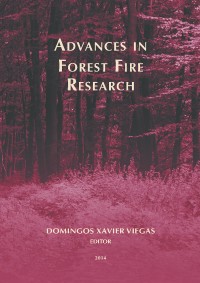Please use this identifier to cite or link to this item:
https://hdl.handle.net/10316.2/34150| DC Field | Value | Language |
|---|---|---|
| dc.contributor.author | Cruz, Miguel G. | |
| dc.contributor.author | Alexander, Martin E. | |
| dc.date.accessioned | 2014-10-21T14:46:18Z | |
| dc.date.accessioned | 2020-09-09T21:32:07Z | - |
| dc.date.available | 2014-10-21T14:46:18Z | |
| dc.date.available | 2020-09-09T21:32:07Z | - |
| dc.date.issued | 2014 | - |
| dc.identifier.isbn | 978-989-26-0884-6 (PDF) | |
| dc.identifier.uri | https://hdl.handle.net/10316.2/34150 | - |
| dc.description.abstract | This paper highlights the results obtained from a comprehensive survey recently published by the authors on the error statistics associated with studies that have used independent data derived from field observations of wildfires, prescribed fires and experimental fires to evaluate the performance of 13 models used operationally to predict head fire rate of spread. Answers to the following kinds of questions were sought: How accurately can one expect to predict the spread rate of wildland fires with currently available models? Can models based on experimental fire data be used to predict wildfire behaviour? Are wildfires inherently more difficult to predict the spread rates of than prescribed fires or crown fires compared to surface fires? How realistic is it to expect an exact prediction of rate of fire spread? What is an acceptable error for rate of fire spread models? A total of 49 studies, comprising 1278 paired observations vs. model predictions of fire spread rates for four forest fuel types (hardwood, mixedwood, conifer, eucalypt) and three non-canopied fuel types (grassland, shrubland, logging slash) from four continents (North America, Australia, Europe, Africa) were assembled. The answers to the five questions asked above are as follows: Mean absolute percent error varied between 20 and 310% and was homogeneous across fuel type groups. Slightly more than half of the evaluation datasets had mean absolute percent errors between 51 and 75 percent. Under-prediction bias was prevalent in 75 percent of the case 49 datasets analysed. Empirical-based fire spread rate models founded on solid field observations and well accepted functional forms, can adequately predict rates of fire spread well outside of the bounds of the data used in their development. There was no evidence to be found that predicting the rates of spread of wildfires was any more difficult than that of prescribed fires. Spread rates of crown fires were no more difficult to predict that surface fires. Only three percent (i.e. 35 out of 1278) of model predictions were considered to be exact (i.e. ±2.5 percent of the observed rate of fire spread). A ±35 percent error interval constitutes a reasonable standard for model adequacy. | eng |
| dc.language.iso | eng | - |
| dc.publisher | Imprensa da Universidade de Coimbra | por |
| dc.relation.ispartof | http://hdl.handle.net/10316.2/34013 | por |
| dc.rights | open access | - |
| dc.subject | fire spread models | eng |
| dc.subject | fire behaviour | eng |
| dc.subject | error | eng |
| dc.subject | surface fires | eng |
| dc.subject | crown fires | eng |
| dc.subject | wildfires | eng |
| dc.subject | prescribed fires | eng |
| dc.title | Uncertainty in model predictions of wildland fire rate of spread | por |
| dc.type | bookPart | por |
| uc.publication.firstPage | 466 | - |
| uc.publication.lastPage | 477 | - |
| uc.publication.location | Coimbra | por |
| dc.identifier.doi | 10.14195/978-989-26-0884-6_54 | - |
| uc.publication.section | Chapter 1 - Fire Behaviour and Modelling | por |
| uc.publication.digCollection | PB | por |
| uc.publication.orderno | 54 | - |
| uc.publication.area | Ciências da Engenharia e Tecnologias | por |
| uc.publication.bookTitle | Advances in forest fire research | - |
| uc.publication.manifest | https://dl.uc.pt/json/iiif/10316.2/34150/211867/manifest?manifest=/json/iiif/10316.2/34150/211867/manifest | - |
| uc.publication.thumbnail | https://dl.uc.pt/retrieve/11177379 | - |
| uc.publication.parentItemId | 53868 | - |
| uc.itemId | 70406 | - |
| item.grantfulltext | open | - |
| item.fulltext | With Fulltext | - |
| Appears in Collections: | Advances in forest fire research | |
Files in This Item:
| File | Description | Size | Format | |
|---|---|---|---|---|
| 978-989-26-0884-6_54.pdf | 2.47 MB | Adobe PDF |  |
Items in DSpace are protected by copyright, with all rights reserved, unless otherwise indicated.
